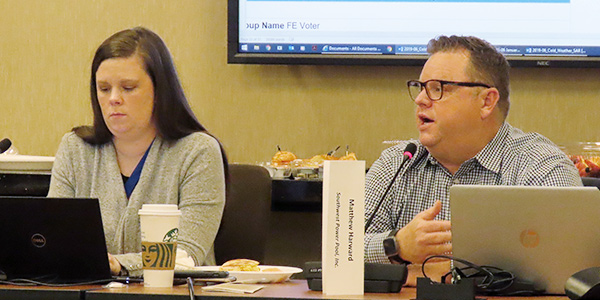By Holden Mann
The team working on NERC’s proposed standard for cold-weather preparedness is revising the draft standard authorization request (SAR) and expects to post the updated document for another round of comments by the middle of February (Project 2019-06).
Debate at this week’s standard drafting team meeting primarily revolved around the cool reception the proposal received last year, with Sam Dwyer of Ameren noting that about 60% of respondents felt a new standard was unnecessary. Even many of the commenters who supported requirements around cold-weather preparedness urged the team to re-evaluate its scope. (See Gen Operators Cool to Winter Preparedness Standard.)
Geographic Splits
The strongest opposition to the proposal came from operators in northern areas, who argued that they already prepare for extreme cold as a matter of course, and that only operators in areas where winters are typically mild need guidance on how to handle extreme events. This argument made little headway with the drafting team, although it acknowledged that regional variations would likely need to be written into the standard.
“My take on that would be that standards should always be stuff you’re already doing. So, to the extent that you’re already doing it, great — it shouldn’t be hard for you to meet the standard,” Kenneth Luebbert of Evergy said. “[On the other hand], I think it’s going to be key [to] allow a lot of variations. … The approach that different plants take will be quite a bit different, whatever requirement we put into place.”
Some members suggested that the team address the geography-based objections by expanding its focus beyond low temperatures to cover any kind of extreme weather such as droughts or hurricanes, with Don Urban of ReliabilityFirst calling the new standard a “golden opportunity” to consider the impact of extreme weather in general.
This idea had little support from the majority of the team, however. Chair Matthew Harward of SPP reminded members that the impetus for the project was a joint FERC-NERC report on the Jan. 17, 2018, cold-weather event in the South Central U.S. Harward warned that trying to tackle too wide a remit could bog down the team and prevent it from reaching a meaningful result.
At the same time, members backed off from attempts to narrow the scope too much, as with Luebbert’s suggestion to focus on coal- and natural gas-fired generators, which accounted for 97% of performance issues cited in the joint report. Michael Brytowski of Great River Energy pointed out that when temperatures in the Upper Midwest dropped to -30 degrees Fahrenheit in early 2019, MISO lost almost 10 GW of wind generating capacity for 36 hours because of cold hydraulics, indicating that any form of generator can suffer from extreme temperatures.
NERC Guidelines Debated
Another topic of disagreement was what role the existing NERC cold-weather guidelines should play in the SDT’s work. Several industry respondents had said that the guidelines were sufficient and that no further requirements were needed; several team members favored simply adopting the guidelines as the new standard in whole or in part.
However, others felt more work was needed. For example, NERC Senior Standards Developer Jordan Mallory observed that “out of the past 12 years, there have been six blackouts [from extreme cold] — that is a problem. … Obviously, the NERC guidelines may not be enough.”
Responding to Mallory, Venona Greaff of Occidental Chemical cautioned that extreme weather events, by definition, are hard to predict and that it is impossible for even the best standard to cover all conceivable scenarios.
“You can do everything right all the time … you [can] look at where the wind blows from [historically] and how low the temperature gets, [but] you can have a one-off [where] the wind blows from a different direction and your wind blocks aren’t there,” she said. Greaff added that issues are more likely to arise at backup facilities, which aren’t used often, than at baseload generators.
“It’s like if you have a car that sits for a month and doesn’t drive — there’s no guarantee it’s going to start when you need it to.”
Observers from FERC urged the team to making their recommendations with the actual working conditions that utilities deal with in mind. Even when generator owners can point to their own cold-weather preparedness plans, they must be prepared to follow through and execute on them, they said.
“They’ve all got plans, and they’re good. … The generator operators [and] owners are very professional about getting plans out,” said Nick Henry of FERC. “The issue would be, after a period of time with moderate winters, and then another one hits you about five or six years later — now your pants are back down around your ankles because you just quit executing.”





